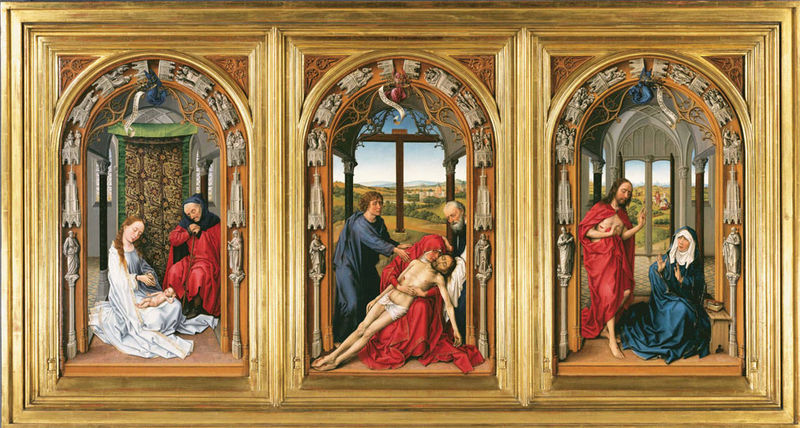The Städel Museum, Frankfurt, in cooperation with the Gemäldegalerie der Staatlichen Museen zu Berlin, dedicated a major exhibition, 21 November 2008 – 22 February 2009, to Robert Campin, the “Master of Flémalle,” and Rogier van der Weyden – a presentation focusing on the still unresolved issues concerning the “ars nova,” that revolutionary new painting emerging in the Burgundian Netherlands, which, with its truthful rendering of details of reality, marks the beginning of modern painting in the early fifteenth century.
Besides the brothers Hubert and Jan van Eyck, the “Master of Flémalle,” often identified with the Tournai painter Robert Campin, and Rogier van der Weyden, who worked for him intermittently and later became “painter to the town of Brussels,” were of crucial importance for the birth and initial development of Early Netherlandish painting. They stand for the discovery of the visible world which they represented in hitherto unknown realistic detail thanks to the sophisticated new technique of oil painting. A precious brocade fabric or the tear on a mourning Madonna’s cheek, the signs of age in a woman’s face, or the snow-covered summits visible far on the horizon – the Dutch painters of the fifteenth century introduced motifs as worth including in a picture that had been unfamiliar in European painting before. As the imagination of that time was profoundly informed by religious notions, these details of the visible world depicted with delusive exactness were also used to hint at a transcendental world beyond the banal everyday reality.
Though the Master of Flémalle, also known as Robert Campin, and Rogier van der Weyden number among the most important and innovative European artists of the fifteenth century, and their paintings like

the “Mérode Altarpiece” in the Metropolitan Museum of Art, The Cloisters,

or the “Miraflores Altarpiece” in the Gemäldegalerie in Berlin belong to the most beautiful and popular works of late medieval art – both works were included in the exhibition in Frankfurt – there has been no monographic exhibition dedicated to the two painters and their oeuvres until today.
However, a direct comparison of the two – particularly in matters of style – is of crucial importance in this case. For the identification of the Master of Flémalle with Robert Campin is still as controversial as the drawing of a clear dividing line between the former’s oeuvre and Rogier van der Weyden’s. Four monumental volumes on the two artists, arriving at partly radically divergent conclusions, have been published only in recent years. Under these circumstances, an exhibition that brought together the two artists’ oeuvres, presenting some of their works together for the first time since centuries, offered a splendid opportunity to make persuasive proposals for a solution based on direct comparisons.
About fifty masterpieces by the two artists were assembled in the exhibition “The Master of Flémalle and Rogier van der Weyden. The Birth of Modern Painting.” They came from the most outstanding museums of the world such as the Museum voor Schone Kunsten in Antwerp, the Gemäldegalerie in Berlin, the Groeningemuseum in Brugges, the Art Institute of Chicago, the Cleveland Museum of Art, the Musée des Beaux-Arts in Dijon, the Museum der bildenden Künste Leipzig, the Museu Calouste Gulbenkian in Lisbon, the National Gallery in London, the J. Paul Getty Museum in Los Angeles, the Museo del Prado in Madrid, the Museo Thyssen-Bornemisza in Madrid, the Metropolitan Museum of Art in New York, the Musée du Louvre in Paris, the State Hermitage Museum in St. Petersburg, the National Gallery of Art in Washington, and the Kunsthistorisches Museum in Vienna.
For the Städel Museum, which possesses one of the most significant collections of Early Netherlandish painting itself, this exhibition represented a landmark for the research in this field, which has been intensely pursued at the institution for many years. An exhibition of the Städel Museum, Frankfurt, and the Gemäldegalerie der Staatlichen Museen zu Berlin.
Further venue: Gemäldegalerie der Staatlichen Museen zu Berlin, 20 March – 21 June 2009
Catalogue: “The Master of Flémalle and Rogier van der Weyden. The Birth of Modern Painting,” edited by Stephan Kemperdick and Jochen Sander, preface by Max Hollein and Bernd W. Lindemann. With contributions by Gabriel Dette, Bastian Eclercy, Beatrix Graf, Stephan Kemperdick, Peter Klein, Antje- Fee Köllermann, and Jochen Sander. English and German editions, numerous illustrations in color, Hatje Cantz Verlag, Ostfildern 2008.

Master of Flémalle, Diptych of the Holy Trinity and the Virgin by the Fireplace

Master of Flémalle, Diptych of the Holy Trinity and the Virgin by the Fireplace

Master of Flémalle, Madonna by a Grassy Bank. Oak panel, 40,2 x 28,5

Master of Flémalle, Virgin and Child with Saints in an Enclosed Garden

Rogier van der Weyden, Portrait of a Young Woman. Oak panel, 34,5 x

Rogier van der Weyden, Workshop, Annunciation Triptych (Center Panel).

The Master of Flémalle, Birth of Christ. Oakwood, 85,7 x 72 cm. Musée

The Master of Flémalle, Fragment of the Bad Thief. Oakwood, 133,7 x